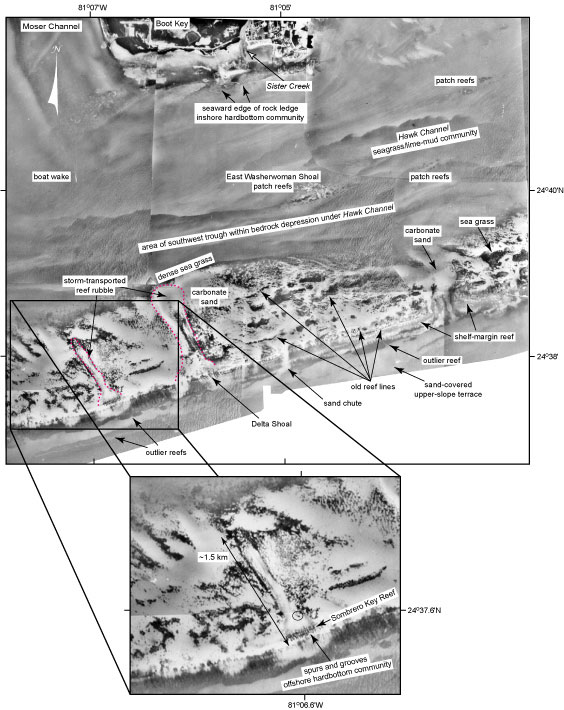FISC - St. Petersburg
Figure 75. Aerial photo (1975) shows regional features in the area of Boot Key near Moser Channel in the middle Keys (modified from Lidz, 2004). Compare with interpreted Benthic Ecosystems for Tile 4. The Seven Mile Bridge crosses Moser Channel. Note area of topographic trough at seaward edge of Hawk Channel. The area pictured is close to the easternmost end of the trough. The trough extends westward to north of Eastern Sambo off the lower Keys (see Benthic Ecosystems map). Patch reefs at East Washerwoman Shoal and elsewhere in the middle of Hawk Channel off the middle and lower Keys formed on its landward edge (Lidz et al., 2006). Indistinguishable from the rest of Hawk Channel in aerial photos, this trough is the second of two on the inner shelf that constitute new coral reef nuclei in the Florida reef record. The other trough lies off the upper Keys (see caption for Fig. 78A). Unlike the trough to the northeast, the southwest trough does not have patch reefs in its center. On the outer shelf, note elongate area of storm-transported coral rubble behind Delta Shoal and Sombrero Key Reef (red dotted lines) and irregularity of skeletal Holocene spurs and grooves at Sombrero Key Reef. Also note numerous areas of sand spillovers or chutes at the shelf-margin reef, caused by topographic relief, and presence or absence of upper-slope outlier reefs. Sediment-grain analyses indicate some of the highest percentages (>60%) of coral grains along the reef tract occur in sediments at Sombrero Key Reef. High coral-grain percentages correlate with high abundances of bioerodable (i.e., skeletal vs. live) coral. Sombrero Key Reef Light and its shadow are circled in the inset.
|
Can't see the printable PDF version? Get the free Adobe Acrobat® Reader. |
